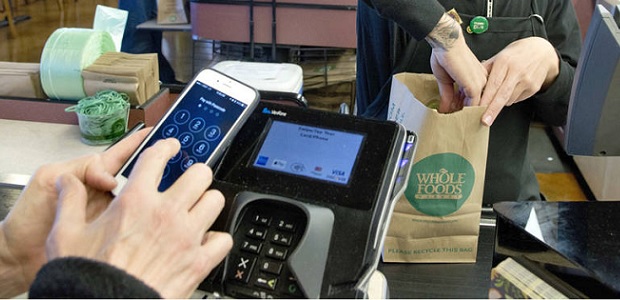
Apple Inc. is planning to launch its mobile payments service in Canada this fall, marking the start of its international expansion of Apple Pay, according to people familiar with the matter, quoted by Wall Street Journal. The company is in negotiations with Canada’s six biggest banks about a potential November launch of the service which would enable mobile payments for both credit and debit cards using iPhones and the forthcoming Apple Watch, those people said.
The banks are open to an agreement, but they aren’t happy with Apple’s fee proposals and are concerned about security vulnerabilities like the ones that U.S. banks experienced as they rolled out the service, the people said.
Lenders in discussions with Apple include Royal Bank of Canada,Toronto-Dominion Bank,Bank of Nova Scotia,Bank of Montreal,Canadian Imperial Bank of Commerce and National Bank of Canada, the people said. Together, those banks account for more than 90% of retail bank accounts, which could provide Apple with near ubiquity upon launch if final agreements are reached.
At this stage, it is still uncertain whether all six banks will launch Apple Pay at the same time because talks are ongoing, those people added.
Canada is an attractive market for Apple Pay because of the high level of iPhone market share. Research firm Catalyst said iPhones account for about one-third of the Canadian smartphone market, compared with the iPhone’s roughly 20% share globally. Additionally, unlike in the U.S., the vast majority of Canadian merchants are already equipped with machines that accept contactless payments through near-field communication, a prerequisite for Apple Pay.
Apple introduced Apple Pay in October for the U.S. market. It allows owners of the latest iPhones to pay for items in stores by waving the device in front of a wireless reader. It has become the most popular service in the nascent but fast-growing mobile payments market. Apple said it accounted for two-thirds of all contactless payments on the three major credit card networks by late January.
Apple has said that the service will become available internationally, while speculation has centered on China and Canada as potential targets for expansion. Unlike its hardware products that can be quickly rolled out globally with minimal amounts of tweaking in individual markets, Apple Pay requires time-consuming negotiations with partners and regulators in every market.
Its attempts to strike a deal in Canada offer a window into the challenges of rolling out Apple Pay abroad.
Canadian banks are aware of the strong interest in Apple Pay in Canada and want to be seen as offering consumers what could be a game-changer in mobile payments. However, Canadian banks are concerned, in part, about what they consider “onerous” terms of commercial agreements for Apple Pay, according to people familiar with the matter. It is also possible that Canadian banks could face higher costs than their U.S. counterparts, some of those people said. A base case for Canadian banks could be in the range of 15 to 25 basis points on credit card transactions to Apple, according to one of those people.
In the U.S., Apple charges 15 basis points per credit card transaction and half-a-cent per debit transaction on Apple Pay, according to people in the payments industry. Apple has never publicly acknowledged its take from Apple Pay transactions. What’s more, Apple is introducing Apple Pay when Canadian banks are grappling with declining credit card revenue and worries about the potential need to absorb higher costs for mobile payments.
Payment networks don’t currently charge higher fees for mobile-based payments than for transactions made using the physical version of the same credit card. But many merchants believe fees could increase once the use of mobile payments spreads.
Security has also emerged as a stumbling block in Apple’s negotiations with Canadian banks amid revelations that U.S. banks are grappling with growing incidence of fraud on Apple Pay, said people familiar with the matter.
As a result, the “Big Six” banks have formed a consortium and hired consultancy McKinsey & Co. to help develop a security protocol for Apple Pay, some of those people said.
U.S. banks were hit by incidents of fraud through Apple Pay when criminals exploited insufficient verification systems by some institutions. The incidents forced some banks to change security procedures to ensure that the person who entered the credit card information into Apple Pay is the true account owner.
Canadian banks want Apple Pay to work in a way that requires a “secondary authentication” to verify customer information before cards can be used with the phones. That means that a consumer could be required to enter a PIN, log-on to a mobile banking app or use a one-time passcode sent via text message before cards can be used on Apple Pay, those people said.
The trouble with that approach, however, is that it creates a clunky experience for consumers who expect mobile payments to be seamless—similar to tap-and-go credit cards that are already in wide use in Canada. Additionally, secondary authentication could create higher costs for Canadian banks, those people added. The banks’ decision to form a consortium on security issues, however, could give them more leverage in the commercial discussions with Apple, some of those people said.
Banking 4.0 – „how was the experience for you”
„To be honest I think that Sinaia, your conference, is much better then Davos.”
Many more interesting quotes in the video below: